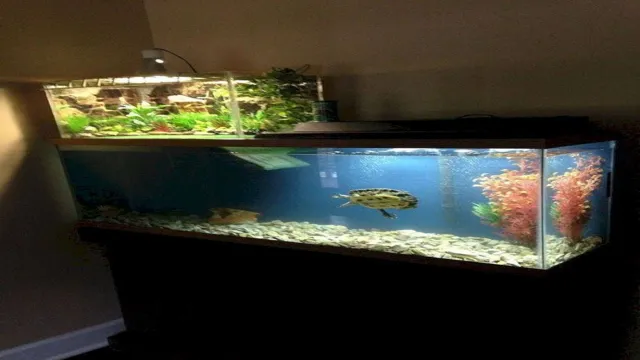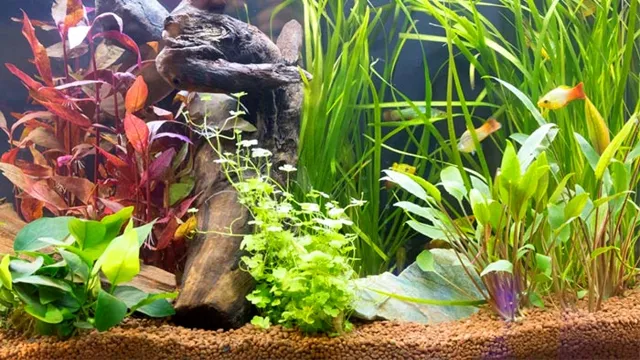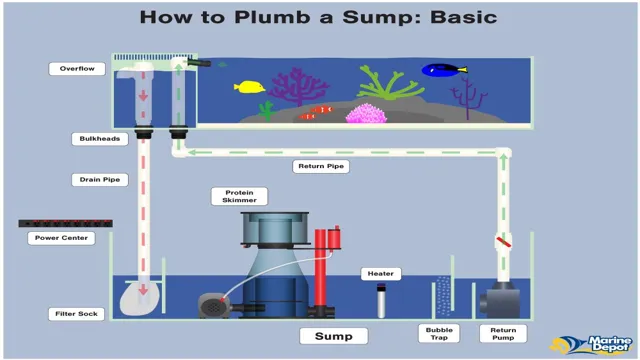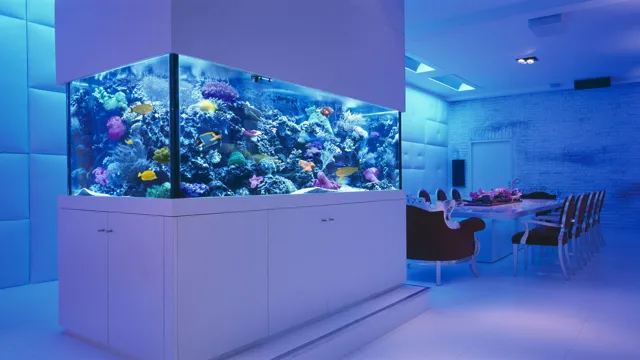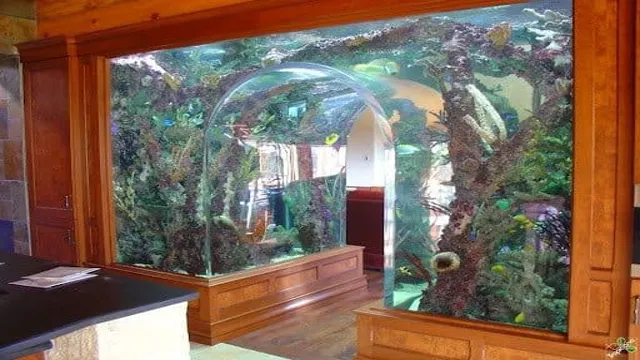Do you have an aquarium and are thinking of adding some turtles to the mix? Creating a turtle habitat in your aquarium can be a fun and rewarding experience, but it’s important to do it right. Turtles have specific needs, and the aquarium environment requires maintenance to keep it healthy for all inhabitants. First, consider the size of your aquarium.
Turtles can grow big, and it’s important to give them enough space to move around comfortably. A good rule of thumb is to provide 10 gallons of water for every inch of shell length. You’ll also need a basking area where your turtles can rest and soak up some UV light.
Next, think about filtration. Aquariums with turtles require powerful filtration to keep the water clean and free of any harmful toxins. Turtles can be messy creatures, so it’s important to clean the tank frequently and test the water regularly to ensure it’s at the right pH level.
When it comes to feeding your turtles, it’s important to give them a balanced diet that includes both plants and protein. You can offer a variety of foods like commercial turtle pellets, vegetables, and insects. It’s also important to provide a calcium supplement to keep their shells strong.
Creating a turtle habitat in your aquarium can be a unique and exciting addition to your home. Just remember to do your research and properly care for your turtles to ensure they thrive in their new environment. With the right setup, your aquarium can become a beautiful home for both turtles and fish.
Choosing the Right Aquarium and Equipment
If you’re considering making a turtle habitat in an aquarium, it’s important to choose the right equipment and accessories to ensure the health and happiness of your aquatic pet. First, select an aquarium that’s appropriately sized for your turtle(s). They should have enough space to swim, bask on a platform or rock, and move around freely.
A filter and heater are also essential components to maintain clean water and a comfortable temperature. Adding plants, rocks, and hiding spots will also make the habitat more engaging and stimulating for your turtle. Keep in mind that different species of turtles have different requirements, so make sure to do your research and tailor your setup accordingly.
With a little planning and attention, you can create a wonderful home for your aquatic pal.
Size and Accessibility
Choosing the right aquarium and equipment is a crucial step in creating a thriving aquatic habitat. The size of the aquarium should be carefully considered, as it will not only affect the well-being of the inhabitants but also determine the amount of space available for equipment. A larger tank may accommodate more fish and plants, but it can also be more difficult to maintain.
Similarly, a smaller tank may be easier to manage, but it can limit the options for species and equipment. Accessibility is also essential when selecting equipment, such as filters, heaters, and lighting. Consider the placement of these items, as well as their functionality and durability.
Ultimately, investing in the right-sized aquarium and high-quality equipment will lead to a successful and enjoyable aquatic experience for both the fish and their human caretaker.
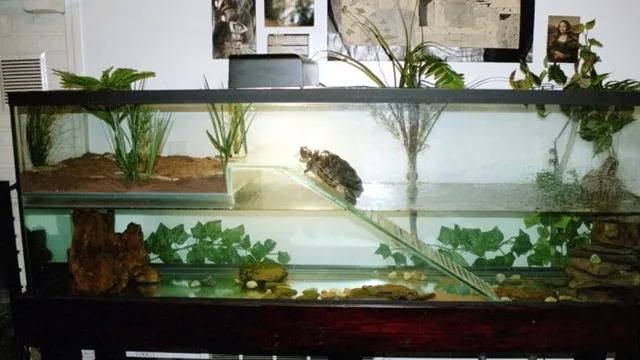
Heaters and Filters
When it comes to setting up an aquarium, it is crucial to choose the right equipment to ensure the well-being of your fish and other aquatic creatures. Two essential pieces of equipment are the heater and filter. The heater is important to maintain a consistent water temperature, as some fish species are sensitive to temperature changes.
It is best to choose a heater appropriate for the size of your aquarium and one with an automatic shut-off feature to prevent overheating. Filters are necessary to keep the water clean by removing debris, toxins, and other harmful substances from the water. There are different types of filters available, including hang-on-back, canister, and internal filters. (See Also: How to Make Liquid CO2 for Aquarium Plants: A Step-by-Step Guide)
It is important to research the different filter types and choose the one that best suits the needs of your aquarium. Remember to clean and maintain your heater and filter regularly to keep them operating at their best. By choosing the right aquarium equipment, you can create a healthy and thriving underwater world for your aquatic pets.
Lighting and Basking Area
When it comes to creating the perfect environment for your fish, it’s crucial to choose the right aquarium and equipment. One important aspect to consider is lighting. Many fish require a specific amount and type of lighting to thrive, and you’ll want to ensure that your aquarium has the appropriate lighting for your fish.
Additionally, you’ll want to provide a basking area for fish that require it. This can be accomplished with the use of a heat lamp or other heating equipment. Overall, selecting the right aquarium and equipment is essential for creating a healthy and thriving environment for your fish.
By doing so, you’ll be able to provide your fish with the best possible care and enjoy a beautiful aquarium for years to come.
Setting Up the Habitat
Creating a turtle habitat in an aquarium is an exciting project for many pet owners. However, before you dive in, you need to ensure that you have everything set up properly. Firstly, pick an appropriate size aquarium for your turtle – typically, the general rule of thumb is ten times the length of the turtle.
Next, add a substrate to the bottom of the aquarium, such as peat moss, coconut coir, or sand. The substrate should be deep enough so that the turtle can bury itself and has a comfortable space to move around. You’ll need to include various decorations and accessories such as logs, rocks, and plants to allow your turtles to climb on or hide behind.
Ensure that any objects you place in the habitat are safe for turtles and do not pose a choking hazard. It’s essential to include a basking spot for turtles to dry off after swimming, such as a heating lamp or UVB bulb. Finally, fill the aquarium with clean, chlorine-free water and any necessary water treatments to make sure the water stays clean and healthy for your pet.
With these steps, you can create a safe and comfortable habitat for your turtle.
Creating the Land Area
Setting up the habitat for your land area can be an exciting and rewarding experience. When creating your land area, it is important to consider the natural environment and the needs of the creatures that will be living there. First, decide on the habitat type you want to create, such as a forest or grassland.
Next, consider the vegetation that is native to that habitat and plant accordingly. This will provide food and shelter to the fauna that will call your land area home. Additionally, incorporate landscape features like rocks, ponds, and fallen logs to create diverse microhabitats within your land area.
Remember to use organic and natural materials, and avoid using pesticides and other toxic chemicals that could harm the environment. By creating a natural and healthy habitat, you will be fostering biodiversity and promoting a sustainable ecosystem for years to come.
Adding Water and Decorations
Now that you have selected the perfect habitat for your pet, it’s time to add water and decorate it to make it feel like home. But before you do, make sure to thoroughly clean and rinse the habitat to remove any residue or debris. Once it’s dry, you can start by adding fresh water to the habitat. (See Also: How to Add a Permanent Divider in an Aquarium: Step-by-Step Guide)
The amount of water you add will depend on the type of pet you have, but a good rule of thumb is to fill it about halfway. You can also add various decorations, such as plants, rocks, and logs, to create a natural and appealing environment for your pet. Just make sure that all decorations are safe and do not have any sharp edges or small parts that can be ingested.
With a little creativity and attention to detail, you can create a beautiful and comfortable home for your pet. So why not add a little personal touch and make it a place they will love to call home?
Maintaining the Habitat
Looking to create a turtle habitat in your aquarium? Firstly, consider the size of your tank and the species of turtle you want to house. Different turtles require different water depths and temperatures, so it’s important to do your research before setting up the habitat. Next, add a substrate layer to your tank’s bottom to allow for burrowing and resting areas.
You can use sand, gravel, or even coconut coir. Add a basking area with a heat lamp, which should be enough to provide warmth and a dry space for your turtle to rest. Make sure the water is clean by using an appropriate filter and performing regular water changes.
Lastly, consider adding some decor or plants to your habitat to enrich your turtle’s environment. By following these steps, you can create a healthy and happy turtle habitat in your aquarium.
Proper Cleaning and Water Temperature
Proper Cleaning and Water Temperature: Maintaining the Habitat When it comes to maintaining a healthy and happy home for your aquatic pets, proper cleaning and water temperature are two crucial factors that cannot be overlooked. Keeping your fish tank clean is essential to prevent the buildup of harmful bacteria, which can negatively impact the health of your fish and other inhabitants. It’s important to follow a regular cleaning regimen, including partial water changes, scrubbing the sides of the tank, and replacing the filter media as necessary.
Additionally, ensuring proper water temperature is key for the health and vitality of your aquatic pets. Different species of fish and other aquatic creatures have specific temperature requirements that need to be met to ensure their well-being. Investing in a reliable aquarium thermometer can help you keep track of temperature fluctuations and make adjustments when needed.
By maintaining a clean and properly temperature-controlled environment, you’re sure to provide a happy and healthy home for your beloved aquatic pets.
Feeding and Care Tips
Maintaining a healthy habitat is crucial for the well-being of any exotic pet. When it comes to rabbits, it’s essential to keep their living space clean and safe. Rabbits are susceptible to respiratory problems, so it’s crucial to keep the area well-ventilated, dry, and free from drafts.
It’s also important to spot-clean daily and do a deep clean once per week. This involves removing all bedding, scrubbing the litter box, and disinfecting the cage’s surfaces. As for bedding materials, paper-based options work well and are safe for rabbits to ingest if they happen to nibble on them.
However, cedar, pine, and straw should be avoided as they can cause respiratory and digestive issues. Additionally, make sure the rabbit has ample space to move around, toys to play with, and access to fresh water and hay at all times. By maintaining your rabbit’s habitat, you’ll ensure they live a happy and healthy life. (See Also: How to Make Brackish Water for Aquarium: A Comprehensive Guide for Hobbyists)
Conclusion
Creating a turtle habitat within an aquarium may seem like a daunting task, but with the right tools and knowledge, it can be a rewarding and enjoyable experience. By keeping in mind the specific needs and preferences of your turtle species, you can create a comfortable and thriving environment that will keep your aquatic shelled friend happy and healthy. Just remember to incorporate plenty of hiding spots, places to bask in the sun, and keep the tank clean to ensure the ultimate turtle paradise.
So, what are you waiting for? Dive in and make a turtle habitat that will have your shelled companion “shell-ebrating” every day!”
FAQs
What materials do I need to make a turtle habitat in an aquarium?
To make a turtle habitat in an aquarium, you will need an aquarium tank, a basking area, a filtration system, a heater, and substrate for the bottom.
How large of an aquarium tank do I need for a turtle habitat?
The size of the aquarium tank you need for a turtle habitat depends on the size of your turtle. A general rule is to have ten gallons of water per inch of turtle shell length.
What type of basking area should I have in my turtle habitat?
Your basking area should include a dry area for your turtle to rest, a heat source, and a UVB light to help your turtle metabolize calcium.
Can I use plants in my turtle habitat?
Yes, you can use plants in your turtle habitat. Just make sure they are non-toxic to turtles and can handle the humidity and potential nibbling.
How often should I clean my turtle habitat?
You should remove any waste daily and do a partial water change once a week. A full cleaning with equipment and substrate changes should happen once a month.
What is the ideal water temperature for a turtle habitat?
The ideal water temperature for a turtle habitat is between 75-85 degrees Fahrenheit.
Can different types of turtles live together in the same habitat?
It is not recommended to house different types of turtles together, as they may have different needs and could potentially harm each other.

